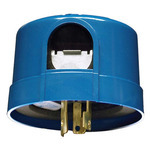Photocells & Photo Control Switches
Automate Your Outdoor Lighting with Photocell Sensors
A photocell sensor is the smart solution for hands-free outdoor lighting control. These light-activated devices automatically turn lights on at dusk and off at dawn, eliminating the need for manual switches or timers. Whether you're illuminating a residential driveway, commercial parking lot, or security perimeter, photocell sensors deliver reliable, energy-efficient automation that adapts to natural daylight changes throughout the year.
What Is a Photocell and How Does It Work?
A photocell, also called a photo control switch, uses a light-sensitive resistor to detect ambient light levels. When darkness falls, the sensor's internal resistance increases, triggering the connected fixture to turn on. At sunrise, the process reverses and the light switches off automatically. This simple yet effective technology has made photocells the go-to choice for wall packs, flood lights, pathway lighting, and landscape fixtures. Unlike traditional timers that require seasonal adjustments, a photocell switch responds to real-time lighting conditions, making it naturally adaptive to daylight saving time changes and weather variations.
Choosing the Right Photocell Sensor for LED Lighting
Not all photocells are created equal, especially when it comes to modern fixtures. If you're using LED technology, it's essential to select a photocell sensor for LED lighting specifically designed for compatibility. Standard photocells may cause flickering, failure to switch properly, or premature burnout when paired with LED loads. LED-compatible sensors account for the lower current draw and unique electrical characteristics of LED fixtures, ensuring smooth operation and long-term reliability.
When selecting your photocell, consider these key factors:
- Voltage rating: Match your system voltage (typically 120V for residential, 277V for commercial applications)
- Mounting style: Choose from locking-type, stem mount, swivel, or fixed position based on your fixture design
- Sensor positioning: Mount facing north in the northern hemisphere to avoid false triggers from direct sunlight
- Load capacity: Ensure the photocell can handle your total wattage if controlling multiple fixtures on one circuit
Benefits of Installing Photo Control Switches
Photo control switches offer compelling advantages beyond simple convenience. Energy savings add up quickly when lights only operate during necessary hours rather than running on broad timer schedules that may leave lights on during bright mornings or cloudy afternoons. Maintenance requirements are minimal, quality photocells typically last 5 to 10 years with no seasonal programming needed. For commercial properties, automated lighting enhances security while reducing labor costs associated with manual light management. The reliability of photocell technology also means fewer service calls and greater peace of mind.
Installation and Usage Tips
Proper installation maximizes photocell performance and lifespan. Always verify that your photocell's voltage rating matches your electrical system before wiring. Standard wiring connects the black wire to your power source, white to neutral, and red to the fixture load. Position the sensor where it has a clear view of the sky without obstruction from eaves, trees, or nearby bright lights that could interfere with accurate readings. Periodic cleaning of the sensor lens helps maintain consistent operation, though photocells are largely maintenance-free devices. If you notice erratic switching or lights staying on during daylight, these are signs your photocell may need replacement.





